
Filipino cuisine is composed of the cuisines of more than a hundred distinct ethnolinguistic groups found throughout the Philippine archipelago. A majority of mainstream Filipino dishes that compose Filipino cuisine are from the food traditions of various ethnolinguistic groups and tribes of the archipelago, including the Ilocano, Pangasinan, Kapampangan, Tagalog, Bicolano, Visayan, Chavacano, and Maranao ethnolinguistic groups. The dishes associated with these groups evolved over the centuries from a largely indigenous base shared with maritime Southeast Asia with varied influences from Chinese, Spanish, and American cuisines, in line with the major waves of influence that had enriched the cultures of the archipelago, and adapted using indigenous ingredients to meet local preferences.

Bistek, also known as bistek tagalog or karne frita, is a Filipino dish consisting of thinly-sliced beefsteak braised in soy sauce, calamansi juice, garlic, ground black pepper, and onions cut into rings. It is a common staple in the Tagalog and Western Visayan regions of the Philippines. It is eaten over white rice.
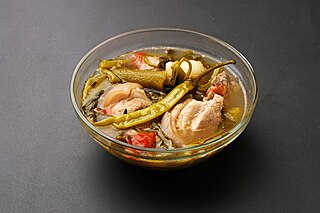
Sinigang is a Filipino soup or stew characterized by its sour and savory taste. It is most often associated with tamarind, although it can use other sour fruits and leaves as the souring agent such as unripe mangoes or rice vinegar. It is one of the more popular dishes in Filipino cuisine. This soup, like most Filipino dishes, is usually accompanied by rice.

Tokwa't baboy is a typical Philippine appetizer. It consists of pork ears, pork belly and deep-fried tofu, and is served in a mixture of soy sauce, pork broth, vinegar, chopped white onions, scallions and red chili peppers. It is usually served as pulutan, as a meal served with rice or as a side dish to rice porridge. Tokwa is the Lan-nang word for firm beancurd, while baboy is the Tagalog word for pork; 't is the contracted form of at, which means "and".
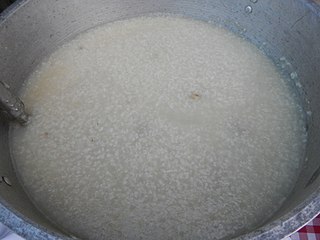
Lugaw, also spelled lugao, is a Filipino glutinous rice dish or porridge. Lugaw may refer to various dishes, both savory and sweet. In Visayan regions, savory lugaw are collectively referred to as pospas. Lugaw is widely regarded as a comfort food in the Philippines.

Philippine adobo is a popular Filipino dish and cooking process in Philippine cuisine. In its base form, meat, seafood, or vegetables are first browned in oil, and then marinated and simmered in vinegar, salt and/or soy sauce, and garlic. It has occasionally been considered the unofficial national dish in the Philippines.

Inihaw, also known as sinugba or inasal, are various types of grilled or spit-roasted barbecue dishes from the Philippines. They are usually made from pork or chicken and are served on bamboo skewers or in small cubes with a soy sauce and vinegar-based dip. The term can also refer to any meat or seafood dish cooked and served in a similar way. Inihaw are commonly sold as street food and are eaten with white rice or rice cooked in coconut leaves (pusô). Inihaw is also commonly referred to as Filipino barbecue or (informally) Pinoy BBQ.
Talunan or talonan is a Filipino chicken soup or stew characterized by its sour flavor. It is prepared like a combination of Philippine adobo and paksiw, with vinegar, garlic, ginger, black peppercorns, patis, bay leaves, and salt. Some recipes add pork to the dish. The name literally means "loser" in Tagalog, as it was traditionally cooked from the tough meat of losing roosters used in cockfighting.

Paksiw is a Filipino style of cooking, whose name means "to cook and simmer in vinegar". Common dishes bearing the term, however, can vary substantially depending on what is being cooked.

Kilawin is a Filipino dish of chopped or sliced meats, poultry, seafood, or vegetables typically eaten as an appetizer before a meal, or as finger food with alcoholic drinks.

Nilaga is a traditional meat stew or soup from the Philippines, made with boiled beef or pork mixed with various vegetables. It is typically eaten with white rice and is served with soy sauce, patis, labuyo chilis, and calamansi on the side.
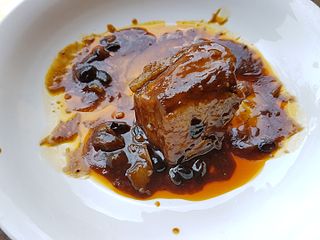
Humbà, also spelled hombà, is a Filipino braised pork dish from Visayas, Philippines. It traditionally uses fatty cuts of pork belly slow-cooked until very tender in soy sauce, vinegar, black peppercorns, garlic, bay leaves, and fermented black beans (tausi) sweetened with muscovado sugar. It also commonly includes hard-boiled eggs and banana blossoms.

Pinatisan is a Filipino cooking process consisting of meat braised in patis, garlic, ginger, onion, black peppercorns, and bay leaves. Some recipes also add non-traditional ingredients like tomatoes, chili peppers, and other herbs and spices. Vinegar may also be added. It is very similar to binagoongan, which is made using fermented shrimp. It is also similar to Philippine adobo and paksiw, but is distinguished by the primary use of fish sauce in place of vinegar. Pinatisan has a strong umami flavor rather than the characteristic sour and sweet flavor of adobo.

Afritada is a Philippine dish consisting of chicken, beef, or pork braised in tomato sauce with carrots, potatoes, and red and green bell peppers. It is served on white rice and is a common Filipino meal. It can also be cooked with seafood.
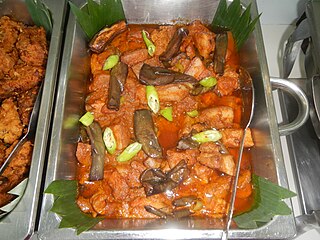
Binagoongan is a Filipino cooking process consisting of vegetables or meat sautéed or braised in bagoong alamang, garlic, black peppercorns, and bay leaves. Some recipes also add pineapples, chilis, or coconut cream to balance the flavors. The dish is characteristically quite salty with a strong umami flavor, which is why it is always paired with white rice and never eaten on its own. It is very similar to pinatisan which is cooked with patis, one of the by-products of fermenting bagoong.
Kadyos, baboy, kag lanka, commonly shortened to KBL, is a Filipino pork soup or stew originating from the Hiligaynon people of the Western Visayas islands. The name of the dish means "pigeon peas, pork, and jackfruit"; the three main ingredients. The soup is also traditionally soured with batuan fruits. Other souring agents like tamarind can also be used. Other ingredients include leafy greens, lemongrass, fish sauce, onions, and siling haba peppers. The pork cut used is typically the hock (pata). The dish is characteristically purple in color due to the use of pigeon peas. It is similar to another Hiligaynon dish known as kadyos, manok, kag ubad which uses chicken and banana pith instead.
Linat-an, also known as nilat-an, is a traditional pork stew from the Visayas and Mindanao islands of the Philippines. Linat-an characteristically uses pork ribs boiled and simmered until very tender, lemongrass, string beans, and starchy ingredients for a thicker soup. Like the very similar nilagang baboy, the rest of its ingredients can vary, but they typically include chayote, water spinach, onion, garlic, pechay, calabaza, and bell peppers. It is seasoned with salt, ground black pepper, and fish sauce to taste.

Batchoy Tagalog, also known simply as batsoy, is a traditional Filipino food originating in the northern Philippines. This soup is made with pork, pork offal, pork blood, noodles, chili leaves or garlic chives, green chilies, garlic, onions, and ginger. It is also referred to as sutsa or syutsa in the province of Quezon and sinuam in Angono, Rizal. This dish is usually paired with or eaten with cooked rice as a viand.

Chicken pastel, also known as pastel de pollo, is a traditional stew or pie from the Philippines made with chicken, sausages, mushrooms, peas, carrots, potatoes, soy sauce, and various spices in a creamy sauce. The sausages used are usually dry chorizos like chorizo de Bilbao or chorizo de Macao, Vienna sausages, and/or hotdogs. It originates from the Spanish dish pastel de pollo, but differs in that Filipino chicken pastel is usually not baked into a pie, uses local Philippine ingredients, and is usually eaten with white rice. It can also be made with pork, in which case it is known as pork pastel. It is commonly served during the Christmas season.
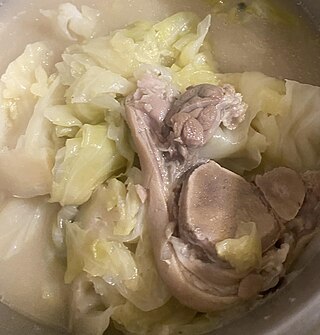
Lauya is a Filipino stew. Its name is derived from the Spanish-Filipino term "la olla", likely referring to the native clay pots in which stews were made in. It is now often associated with the Ilocano stew typically made with pork or beef. The term is sometimes used in Ilonggo cuisine.




















